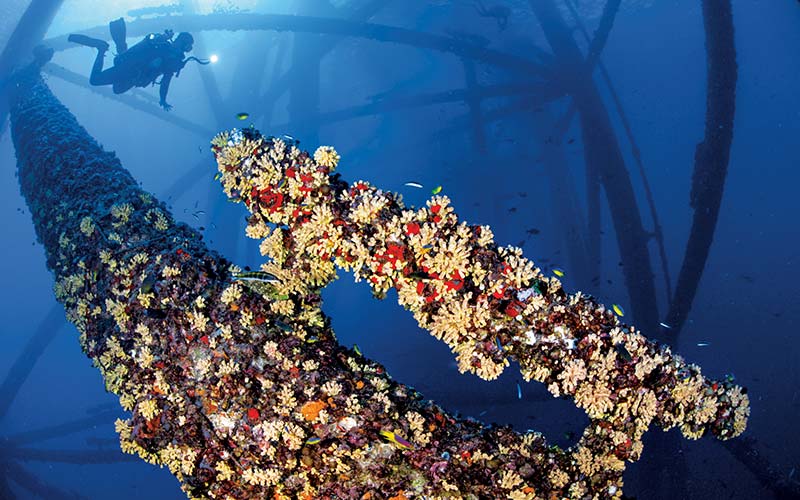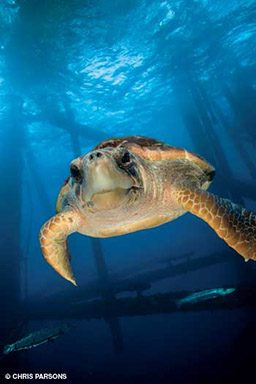I clearly remember the first time I dived an offshore platform. The structure towered above our dive boat like an enormous factory, sitting atop huge, weather-beaten legs that disappeared into the blue Gulf of Mexico. From the surface, it wasn’t terribly attractive. But within the mazelike structure underwater, I discovered a marine wonderland. There were corals, sea fans, sponges, large schools of jacks and snapper, four- and five-foot barracudas, sharks, tiny reef fish, crustaceans and even sea turtles. The marine life ranged from splash to 100 feet and beyond, where blue faded to deep purple. It was a natural aquarium with no bottom in sight.
Islands of Life
The northern Gulf of Mexico contains the vast majority of the nation’s platforms (almost 3,000), and there are another 23 off southern California. Although the terms are often used interchangeably, a rig is a derrick that drills a well, and a platform is the structure that’s built once a well is completed. The number of platforms began to climb rapidly in the 1960s, and they quickly became de facto artificial reefs. Government scientists estimate that a typical four-legged platform is equivalent to two to three acres of marine habitat.
“We’ve done quite a bit of research, and these structures are even more important than we first imagined,” said Greg Stuntz, Ph.D., chair of Ocean and Fisheries Health at Harte Research Institute for Gulf of Mexico Studies at Texas A&M University, Corpus Christi. “We see elevated abundance of fish and high diversity. We’re confident at this point saying platforms do increase productivity in the Gulf.”
According to marine biologist and filmmaker Soames Summerhayes, estimates of fish populations around individual platforms range from 12,000 to 30,000. “Extrapolate that number using the number of existing rigs, and you could hazard a guess of between 40 and 100 million additional fish as a result of these platforms in the northern Gulf.”
Despite that potential value to the marine ecosystem, U.S. Department of Interior (DOI) rules require companies to remove nonproducing structures within one to five years, depending on location and drilling lease status. More than 4,000 platforms have already been removed from the Gulf, and the pace accelerated after a September 2010 notice from the DOI reminding offshore operators of the rules. At least 359 platforms are scheduled for removal in 2013.
Legitimate reasons for removing nonproducing platforms include the possible hazard to shipping and the potential for spills or leaks from aging structures — risks that increase if platforms are damaged or toppled by storms. Some environmental groups also support removal as a way to return the Gulf to a more natural state. But many divers, fishermen and scientists want to keep these oases of life right where they are.
Rigs of Reefs

It’s possible to preserve these structures by officially converting the platforms to artificial reefs. The process requires approval by the DOI’s Bureau of Safety and Environmental Enforcement, environmental review by the Bureau of Ocean Energy Management and permits from the U.S. Army Corps of Engineers. Federally endorsed, state-run rigs-to-reefs programs exist in Texas, Louisiana, Mississippi, Alabama, Florida and California. These programs are funded by donations from platform owners of an amount equivalent to half of what removal would cost. To date, approximately 420 platforms (10 percent of those removed) have been converted in the Gulf. Most were moved to a designated reef site and dropped on the sea floor, although some were cut off below the surface and left in place. In Texas, of 133 platforms converted to reefs to date, only 34 were reefed in place, and all of those were cut off at 85 feet or deeper.
Rigs to reefs isn’t a perfect solution. Offshore companies say the lengthy process can be more trouble than it’s worth. Many of the reefs are too deep for divers, while others lie on silty bottom with poor visibility. Efforts are afoot to solve these problems; these include two bills currently before congress (see info box) and official requests by various elected officials and interest groups to DOI Secretary Ken Salazar requesting a moratorium on platform removal.
Treasures or Trash?
Standing platforms make the best dive sites because of their vertical profiles. A prime example is High Island 389A, a platform erected in 1989 that fell inside the Flower Garden Banks National Marine Sanctuary (FGBNMS) when the sanctuary was designated in 1992. In January 2012, 389A went on the government list for removal.
Jesse Cancelmo, who first dived at the Flower Gardens in 1977, calls 389A a world-class artificial-reef dive. Cancelmo chairs the FGBNMS sanctuary advisory council’s artificial-reef working group, which is investigating alternatives to full removal of platforms in the sanctuary. Proposed expansion of the sanctuary could put several more platforms within its boundaries. The working group recommended partial removal of 389A: cutting the platform off 60 feet below the surface — the depth at which natural reef in the sanctuary begins. This would allow an additional 25 vertical feet of structure compared to the depth (85 feet) at which rigs subject to cutting are usually cut off. The sanctuary advisory council endorsed that recommendation.

“We’ve always said we’re open to the reefing-in-place option,” said G.P. Schmahl, sanctuary superintendent. “But there are many issues, primarily financial and legal, that make it difficult.” The platform owner doesn’t want the ongoing liability, and Schmahl said the government doesn’t either. Putting 389A under the Texas rigs-to-reefs program is one potential solution.
There are still negatives to leaving platforms in place, however. “Platforms aren’t actually good habitat for coral, and most of what is on them is invasive,” Schmahl said. “Platforms are essentially vectors for invasive species.” While other scientists agree that is true, some also say invasions would happen with or without platforms.
A larger issue is that platforms will eventually corrode and collapse. “We don’t know if that’s a problem,” Schmahl said, “but from a management point of view, it’s an important question. We also should be looking at the bigger picture of marine spatial planning. How many platforms should we save? Is it better to place them in aggregations in designated locations? Those are some of the questions we need to answer.”
Cancelmo would like to see each individual platform assessed for its value as marine habitat before removal. “We don’t have a one-size-fits-all solution,” he said. “There are platforms out there that probably don’t merit being left in place, but there are many that do. As long as the structure poses no hazard and liability can be adequately addressed, there’s no reason whatsoever to not leave the platforms in place.” And, from a diver’s perspective, there are plenty of reasons to do so.
What Can You Do?
Let your federal (and, if applicable, state) representatives know these structures are important to divers. Two bills before Congress would make decommissioning rules more favorable to artificial reefing: S1555, the Rigs to Reefs Habitat Protection Act, and S3525, the Sportsmen’s Act of 2012.
Go diving on an offshore platform. You won’t be disappointed.
© Alert Diver — Q1 Winter 2013